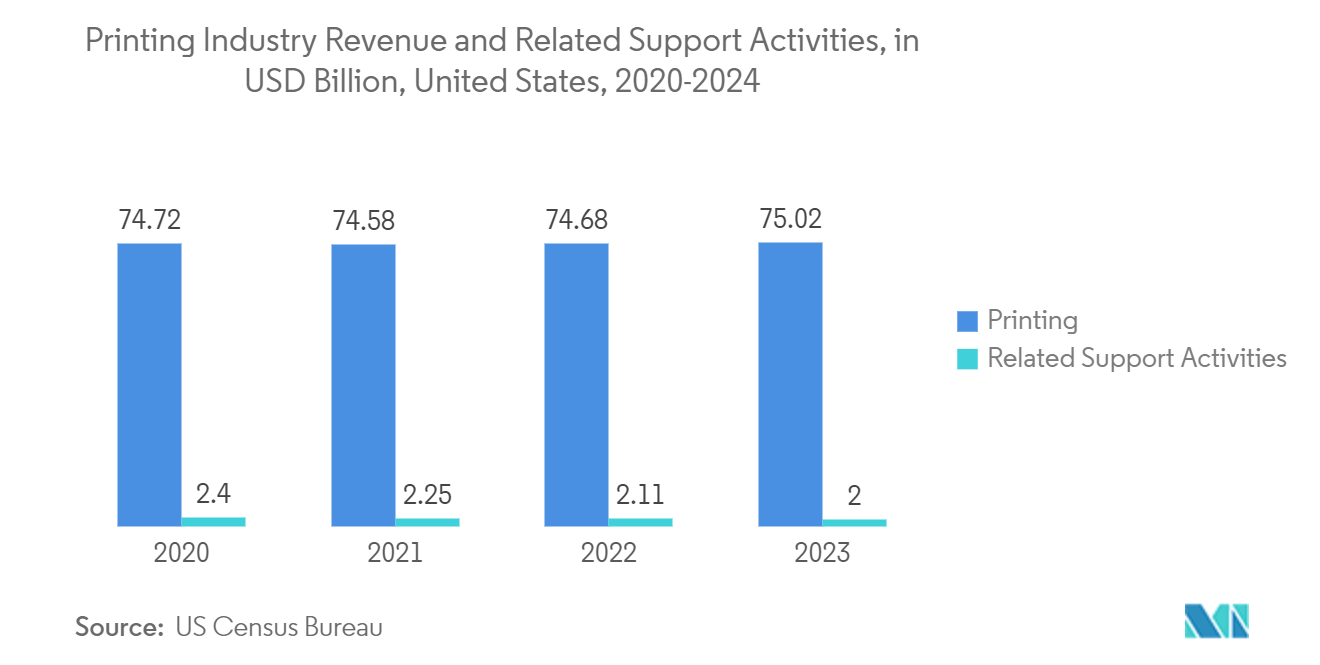Market Trends of North America Commercial Printing Industry
Packaging Application Segment is Expected to Hold Significant Market Share
- In recent years, sustainability has emerged as a top priority for consumers. Shoppers increasingly favor companies that actively work to reduce plastic usage and safeguard the environment. The print sector produces billions of tons of paper annually, demonstrating its dedication to minimizing environmental impact to capture a larger market share. Industry-wide initiatives have concentrated on waste reduction.
- Heightened partnerships between converters and retailers in packaging have created innovative strategies to attract customers. The rise of online shopping and the emphasis on personalized experiences have further propelled the printing market within the packaging sector.
- According to Pulp and Paper Technology, an online publisher in the pulp and paper sector, paper-based packaging provides unmatched design flexibility. Businesses can craft unique shapes, sizes, and prints, bolstering their brand identity and elevating the customer unboxing experience. With the advancements in digital printing technologies, producing high-quality, tailored packaging has become more straightforward and economical. According to the US Census Bureau, the revenue from printing in 2020 was USD 74.72 billion, and it reached USD 75.02 billion in 2024.
- Retailers are turning to paper-based packaging for diverse consumer goods. Furthermore, with customizable designs and printing options, retailers can craft distinctive packaging that enhances customer experience.
- Commercial printers are turning to digital technologies to enhance packaging print quality as digital information delivery gains prominence. Demand for printing on packaging and labels is notably rising, particularly in the healthcare and other sectors. This increase in demand is primarily driven by companies striving to meet changing government regulations and combat counterfeiting.
- In April 2024, Amcor unveiled a major enhancement of its North American printing and converting capabilities tailored for the dairy market, addressing the rising demand for flexible packaging. Over the next 18 months, Amcor is expected to install cutting-edge equipment, predominantly in northeast Wisconsin.
- This move aims to boost capacity, enhance network reliability, and ensure swift responsiveness to the vital dairy market while shifting toward sustainable packaging. This investment highlights Amcor's unwavering commitment to the future of dairy packaging, focusing on enhancing capabilities, harnessing cutting-edge technologies, and providing invaluable expertise to its clientele.

Canada is Expected to Hold Significant Market Share
- According to the International Trade Administration, in November 2023, over the past decade, Canadian consumers have increasingly turned to the Internet for orders, with online sales outpacing traditional retail growth. In response, Canadian retail firms have embraced wireless technologies and internet-based systems to enhance business-to-business and business-to-consumer relations.
- In 2022, Canada boasted over 27 million e-commerce users, representing 75% of its population, and it is expected to rise to 77.6% by 2025. As more Canadians shop online, retail e-commerce sales continue their upward trajectory. In response to this growing trend and competition from giants like Amazon Canada, retailers are increasingly channeling investments into digital platforms to connect with consumers across the vast Canadian landscape.
- As e-commerce grows, the demand for premium packaging materials, labels, and other printed products to enhance online shopping experiences has surged. According to StatCan, in April 2024, e-commerce sales amounted to approximately CAD 3.99 billion (USD 2.96 billion).
- The commercial printing market witnessed a significant boost due to the rise of digital printing technology. Major industry players are actively pursuing expansions in their digital printing offerings in the region. These strategic moves aim to diversify their service portfolios, streamline operations, and cater to the increasing demand for premium, tailored printing solutions. With the evolution of digital printing technology, businesses are achieving quicker turnaround times.


